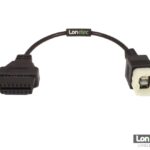For car owners and DIY enthusiasts, understanding what’s going on under the hood is becoming increasingly important. When that dreaded check engine light illuminates, the first step is often figuring out what’s causing it. That’s where OBD2 code readers come in handy. Recently, I had the chance to test out the Autel Al319 Obd2 Can Code Reader, a popular entry-level tool designed to help you diagnose basic car problems. Having used various scanners in the past, including larger, more complex models, I was curious to see how this compact and affordable device would perform. Here’s my detailed review based on hands-on experience.
First Impressions and Ease of Use
Upon unboxing the Autel AL319, the first thing that struck me was its size. Compared to older scanners I’ve used, like the Actron 9180 which was quite bulky, the AL319 is remarkably compact and lightweight. The device itself is straightforward, featuring just three buttons. Two navigation buttons and an “ENTER/Exit” button control the device’s functions.
Connecting the AL319 to my vehicle was a breeze. It plugs directly into the OBD2 port, typically located under the dashboard. The device powered up quickly, drawing power directly from the car. Navigating the menus, however, presented a slight initial learning curve. My instinct was to use the “ENTER/Exit” button to go back to previous screens, but it turns out you need to scroll through the menu options to find the “Return” function. While not immediately intuitive, this is a minor issue that’s easily overcome after a few minutes of use or a quick glance at the manual. Think of it as a slight quirk rather than a major flaw.
Key Features and Performance
Despite its simplicity, the Autel AL319 packs a range of useful features for basic car diagnostics:
Rapid Boot-Up and Clear Display
One of the first things you’ll appreciate is how quickly the AL319 boots up. There’s no waiting around – it’s ready to use almost instantly. The bright, color screen is another plus, making it easy to read codes and data, even in varying lighting conditions.
Emission Readiness Test
A standout feature is the dedicated I/M Readiness button. With a single press, you can quickly check your vehicle’s emission system status. A green light indicates all systems are ready for an emissions test, a yellow light signals that some monitors aren’t ready, and a red light warns of potential emission-related issues that need attention. This is incredibly useful for pre-emission test checks.
Reading Generic and Manufacturer-Specific Codes
The AL319 is capable of reading standard OBD2 codes, which cover a wide range of engine-related issues. Impressively, it can also detect some manufacturer-specific codes. When a manufacturer-specific code is detected, the device prompts you to identify the vehicle’s make and model for more accurate information. It’s important to note that this code reader is designed for basic engine diagnostics and does not access systems like transmission, ABS, or airbags. However, for diagnosing check engine lights, it’s more than adequate.
Live Data Stream
Beyond just reading error codes, the Autel AL319 also provides live OBD2 data. This allows you to monitor real-time engine parameters such as coolant temperature, O2 sensor readings, and more. This live data functionality is genuinely useful for troubleshooting beyond simple code reading. What impressed me was the refresh rate of the live data screens – they are fast and smooth, making it practical to observe data changes in real-time. This is a significant advantage over some other basic scanners where live data can be clunky and slow.
Responsive and Compatible
Navigating through the menus is quick and responsive, contributing to a smooth user experience. I tested the AL319 on various car makes and models, including Honda, Toyota, Subaru, VW, and Nissan, and it worked flawlessly with each one. As long as your car is OBD2 compliant (which most modern vehicles are), you should have no compatibility issues.
Minor Drawbacks
While the Autel AL319 is a solid tool, there are a couple of minor drawbacks to consider:
User Interface Navigation
As mentioned earlier, the menu navigation isn’t the most intuitive at first. The lack of a dedicated “Exit” or “Back” button might confuse users initially. However, this is a small learning curve and becomes second nature with a little practice.
Cable Length
The attached cable is approximately 2 feet long and non-detachable. For most standard diagnostic tasks, this length is sufficient. However, in certain situations, a longer cable would be beneficial. For example, if you want to keep the scanner visible while driving and monitoring live data, or if you need to position the scanner outside the car while working under the hood on a lift, the short cable might be restrictive.
Final Verdict
Despite these minor points, the Autel AL319 OBD2 CAN Code Reader is an excellent entry-level diagnostic tool. Its strengths – fast boot-up, clear display, emission readiness test, manufacturer-specific code reading, responsive live data, and broad compatibility – far outweigh its minor shortcomings. For DIY car owners looking for a reliable and affordable way to diagnose check engine lights and understand basic car issues, the AL319 is a highly recommended choice. It’s a device that I’ll be keeping in my car for quick diagnostics on the go. It’s also a great tool for tasks like fine-tuning engine parameters where live data monitoring, such as coolant temperature, is needed. For its price and capabilities, the Autel AL319 delivers exceptional value.
